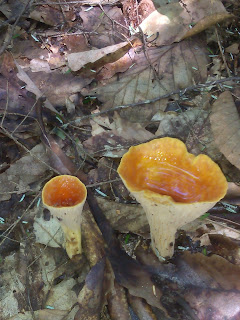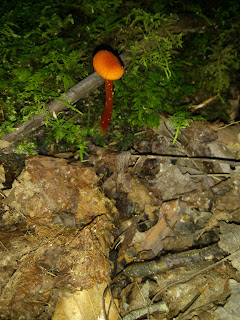Here are some of my favorite Fungus and Lichen sightings
from this summer. I thought when I unpacked all the books
I brought home from school, my fungus identification book
would show up but, much to my disappointment, no such luck.
:-(
I think these are called Indian Pipes - that is the only
one of the group that I have even an idea about. I know
that the members of the kingdom are notoriously difficult
to identify even with a key.
This one makes me think of garden sprites and gnomes.
I love these minute garden vignettes that you find on the rotting logs
or growing on bare rock...decay... succession... death... rebirth ~the cycle of life.
Slime Mold? Like lichen, not neatly classified. I'm not sure that is
what this is, but it is obviously slimy and certainly appears to be molding.
This is just a tiny little specimen - I found a much larger patch of it later.
It looks like staghorn coral to me and I think it has a similar name.
Here it is in a yellow version.
Isn't this cool!? It is only about 3cm tall.
...and an orange version.
I love everything about lichen! The fact that it is actually two organisms
from 2 different kingdoms, it's many different forms; it is both an indicator species
and a pioneer species. American Indians used it for dye and medicine and reindeer eat it.
This is growing out of the side of a tree and looks a little like a shelf fungus,
but I don't think it is. It is soft and a little fuzzy and mostly hollow inside. There
was a slug inside - perhaps it had eaten its way in?
All this needed was a little frog peeking out...and a different forest...
Button Fungus? Maybe I made that up. The caps were
the size of shirt buttons, but it looked like a bouquet.
Rock Garden
This was so cool...red-orange on the inside, creamy on the outside.
About 5 x 6 cm on a short fat stalk.
This little beauty is about 3cm tall - tiny, thin stalk
and a cap about the size of a small button.
Fungi can be identified by their spores and making spore prints was an activity I did with my 7th
graders back in the day when we did science because it was cool as opposed to science to take a test.
Spores, like pollen, are as individual as the organisms that they come from and are one of the ways that scientists identify and date ancient climates and habitats.
G'ma Nancy loaned me her July/August Discover magazine. There is an awesome article for you mycology fans, "Mushroom Manifesto". Adam and LeAnna, I wonder if this is the source of your
mushroom boxes from last Christmas?? REALLLY interesting!!
(This is a special edition Discover, Invisible Planet, and it is awesome if you can get a hold of it.
Thanks, Mom...I really will return it)
















Great collection you've got going here! The diversity is pretty unbelievable. We don't have much in the way of mushrooms but LeAnna said with all the rain we've gotten lately the goat-heads are back with a vengeance :(
ReplyDelete